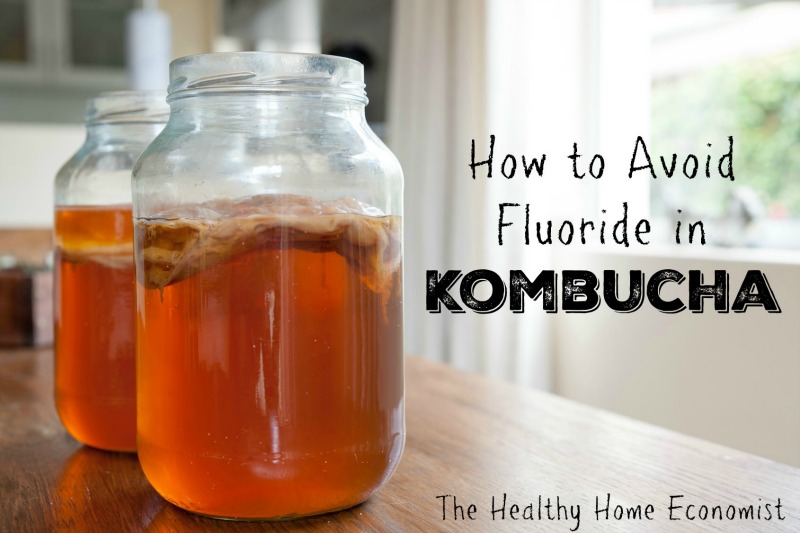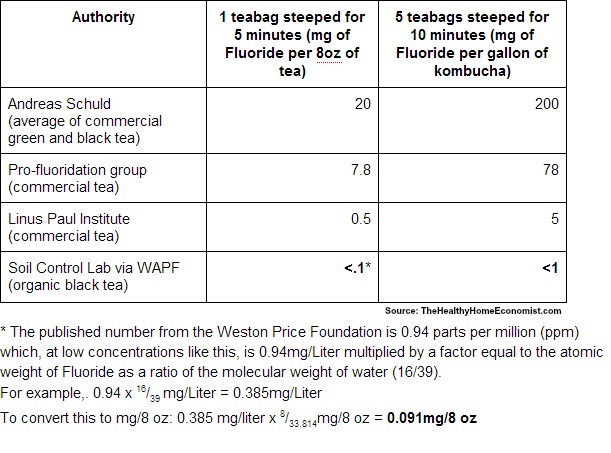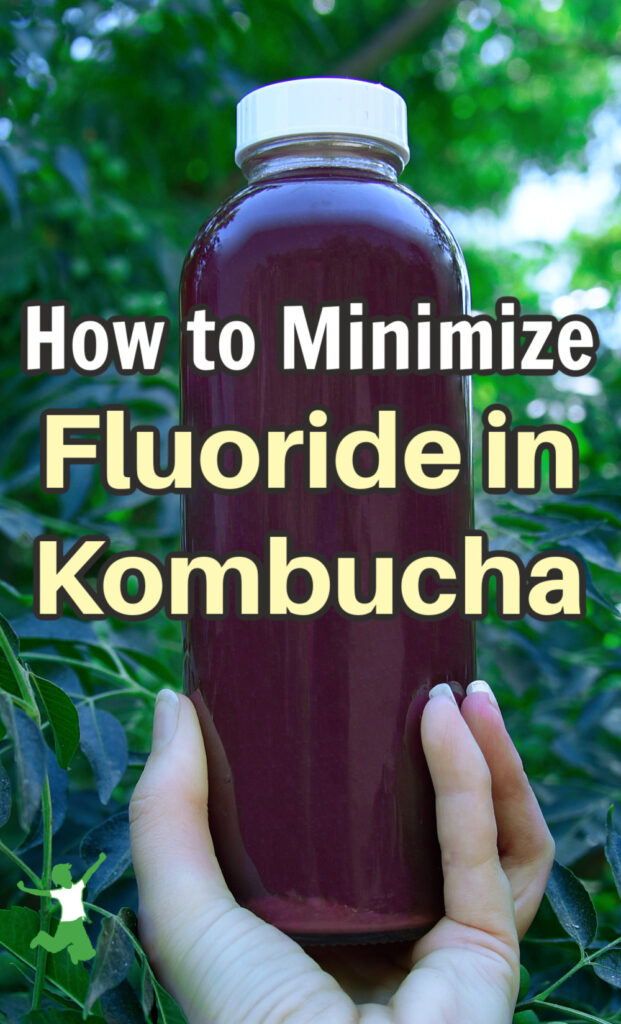Table of Contents[Hide][Show]
- Is Organic Tea Safe?
- How Does Kombucha Compare with Fluoridated Water?
- How to Drink Kombucha Safely
- Fluoride Detox
10 Ways to Avoid Fluoride in Kombucha+−
- Source high-quality organic tea
- Use organic white tea
- Check tea country of origin
- Steep tea water no longer than 10 minutes
- Avoid bottled kombucha from the store
- Use only nonfluoridated water for making kombucha
- Make kombucha with other herbal teas
- Maximize fermentation time
- Drink kombucha in moderation
- Learn to make other fermented beverages
Strategies for avoiding fluoride in kombucha whether you brew your own or buy at the store so you can continue to enjoy this healthful and traditional beverage without toxic downside.

Does homemade kombucha contain too much fluoride to risk drinking it?
What about commercial brands? Will they eat away at the enamel on your teeth and cause dental issues over time?
Given the devastating health effects, particularly on growing children, it is certainly right to investigate the potential for high fluoride levels in kombucha. (1)
This traditional Russian drink is made from fermenting plain black tea (or a combination of black and green tea) and sugar.
The Fluoride Action Network lists black and green tea consumption as the sixth top reason for fluoride overexposure. (2, 3)
Consumption of fluoridated water is #1. The reason is that the leaves of the tea plant tend to accumulate high levels of fluoride which they take up from the soil. (4)
Drinking excessive amounts of tea can cause a painful bone disease called skeletal fluorosis. This is particularly an issue for bottled or instant tea. (5)

I am no stranger to the devastation of skeletal fluorosis.
The picture above is of a cow crippled by fluorosis in Polk County, Florida. This is just a few miles from where I live.
Cattle Health Devastated by Fertilizer Production
The cause of widespread fluorosis in cattle in Central Florida in decades past resulted from the creation of phosphate plants in the 1940s.
Raw phosphate contains high concentrations of fluoride estimated between 20,000 and 40,000 parts per million or 2-4% of the ore.
When raw phosphate ore is processed into water-soluble phosphate via a chemical reaction with sulfuric acid, large amounts of fluoride are vaporized into the air which can contaminate surrounding land with toxic fluoride in the form of hydrogen fluoride and silicon tetrafluoride. (6, 7)
As a result of the land contamination from the phosphate industry, the cattle population of Polk County, Florida dropped by 30,000 between 1953 and 1960.
Farmers fearing for the health of their herds caused an estimated 150,000 acres of cattle land to be abandoned.
According to the former President of the Polk County Cattlemen’s Association:
Around 1953 we noticed a change in our cattle… We watched our cattle become gaunt and starved, their legs became deformed; they lost their teeth. Reproduction fell off and when a cow did have a calf, it was also affected by this malady or was a stillborn. (8)
Fluoride Residues in Tea from Commercial Fertilizer, Pesticides and Herbicides?
With one of phosphate’s primary uses being the production of commercial fertilizers, the possibility of fluoride residues being absorbed by commercial tea crops being repeatedly treated with phosphate-based fertilizers is a very real concern.
It is already known that dairy cattle can suffer the effects of severe fluorosis simply through the use of mineral supplements made using mined phosphate.
In addition, commercial crops are treated with an array of pesticides and herbicides, 150 of which include fluoride according to the Organic Consumers Association.
The category “Fluorine Insecticides” includes Cryolite, Barium hexafluorosilicate, Sodium hexafluorosilicate, Sodium fluoride, and Sulfluramid, and the herbicides Trifluralin, Fluometuron, and Benefin (Befluralin). (9)
Is Organic Tea Safe?
With the potential for high levels of fluoride in the soil and uptake by commercially grown tea plants, it seems best to avoid drinking commercially grown tea as much as possible.
What about organic tea?
While studies on fluoride levels in organic tea are sparse, the results are very encouraging.
In tests performed on organic tea by the Weston A. Price Foundation, levels of fluoride in organic tea were found to be very low compared with commercial tea and even lower in kombucha brewed with organic tea.
According to the USDA, commercial black tea was found to contain fluoride at levels of 3.37 parts per million (ppm) in 2005.
Tests on organic tea made with filtered water by the Weston A. Price Foundation found fluoride levels nearly 75% lower at .94 ppm and even lower in kombucha brewed with organic tea (.9 ppm). The testing was performed by Soil Control Lab, Watsonville, CA.
These results suggest that fermentation of the sugar tea water into kombucha may potentially remove some of the fluoride from the tea perhaps via absorption from the kombucha culture itself.
How Does Kombucha Compare with Fluoridated Water?
Probably this statement in an article from Orawellness generated the most concern:
One 16 ounce serving of kombucha can contain as much fluoride as 6 gallons of fluoridated water.
This article addressed the worst of all possible scenarios and did not include available data on organic tea.
I’d like to provide another perspective with the chart below that includes a best-case scenario using data on fluoride in organic tea published by the Weston A. Price Foundation. (10)

In summary, the worst-case scenario of 200 mg of fluoride per gallon of kombucha translates to 25 mg of fluoride per 16 oz serving.
While this is indeed high, two other sources measured significantly less even when commercial tea was used.
The Weston A. Price Foundation measured an even smaller amount of fluoride when organic black tea was used to brew the kombucha.
So does a 16 oz serving of kombucha contain as much fluoride as 6 gallons of fluoridated water?
Not if organic black tea is used.
And, if organic white tea is used, the already low levels of fluoride are reduced even further.
White tea is made up of the buds and very young leaves of the tea plant and contains less fluoride than even organic green or black tea.
How to Drink Kombucha Safely
The Fluoride Action Network says that the ideal goal of consuming tea safely without excessive levels of fluoride is an attainable objective.
The key is for consumers who drink tea and fermented teas like kombucha to be aware of how to source and brew these healthful beverages.
This is not such a different task than learning to source quality meats, vegetables, or dairy.
Ultimately, enjoyment of the many anti-oxidant, enzymatic, and probiotic properties of fermented kombucha tea is the goal. At the same time, minimizing excessive fluoride exposure is very important.
Fluoride Detox
If you think you’ve consumed too much fluoride via kombucha or other sources in the past, here’s how to do a fluoride detox to flush the body tissues.
The body stores fluoride primarily in the pineal gland, brain, bones, and teeth.
Then, start fresh with these 10 ways listed below on how to brew your kombucha and drink it too.
10 Ways to Avoid Fluoride in Kombucha
Below are ten ways to ensure your kombucha has low to no fluoride and is safe to enjoy regularly.
Source high-quality organic tea
It is important to avoid commercial tea grown with the use of pesticides, herbicides, and commercial fertilizers. The risk is high that they contain toxic fluoride residues from industrial waste sources.
Tea grown organically will only take up natural fluoride present in the soil which will be at much lower levels.
Traditional cultures that consumed kombucha cultivated tea in pristine organic soil. This ensured that the minerals were naturally in balance with no ill effects.
Use organic white tea
Older tea leaves not only contain fewer anti-oxidants but they also contain up to 20X more fluoride! Making kombucha with higher quality, young tea leaves will boost the health effects of the fermented tea while also minimizing fluoride.
White tea is made with the leaves and buds of the tea plant and would be the highest quality of all and also lowest in fluoride.
In my experience, approximately 20% of the tea used to make kombucha needs to be black tea to achieve optimal fermentation.
Thus, using a small amount of high-quality organic black tea with the rest organic white tea and filtered water would be a very low fluoride strategy. This is the brand I use.
Check tea country of origin
The World Health Organization lists areas of the world where the groundwater is naturally high in fluoride such that it affects the fluoride levels of crops.
These areas include large parts of Africa, China, the Middle East, and southern Asia (India, Sri Lanka).
If you aren’t sure of the source of your tea, call the company and ask! Buy only buy from areas where the tea is not grown in a known fluoride belt.
Steep tea water no longer than 10 minutes
Longer steeping times appear to increase the fluoride content of the tea water.
The minimum time for steeping is 5-10 minutes in my experience. Be sure to set the timer and remove the tea from the tea water immediately when time is up!
Avoid bottled kombucha from the store
There is no way to know if manufacturers use high-quality, young tea leaves to make commercial kombucha brands.
Most likely not as older tea leaves are cheaper than young ones.
In addition, it is unknown how long the companies steep the tea in the sugar water.
As a result, it is best to make your own kombucha where you can control the quality. Reserve the bottled kombucha for infrequent occasions.
In fact, I have reviewed lab results for one of the most popular kombucha brands available in the United States. A subscriber paid to have a bottle tested and sent me the labs. It was off the charts high in fluoride!
I contacted the company and got no response in return. This is very concerning.
In my opinion, it is wise to avoid commercial kombucha given the unknowns about its production.
Use only nonfluoridated water for making kombucha
This recommendation goes without saying, but I have come across people who make kombucha with tap water that is filtered with a device that does not remove fluoride, so it bears mentioning.
Make kombucha with other herbal teas
Yerba maté and rooibos (red tea) both make excellent kombucha according to Hannah Crum of Kombucha Kamp.
Neither of these herbs has high fluoride uptake.
Maximize fermentation time
Ferment your kombucha as long as possible! It seems likely from early test results that the fermentation process removes some of the fluoride from the tea.
The suggested time for fermentation is 7-10 days under home temperatures between 65-80F. Thus, it is wise to opt for a longer fermentation time rather than a shorter cycle.
Longer fermentation results in a stronger drink. However, you can dilute with a bit of filtered water or bubbly spring water if necessary to cut the taste.
Drink kombucha in moderation
Drinking kombucha with abandon is not a good idea. I personally do not allow my children to drink more than 4-8 oz per day.
I myself do not drink more than 12-16 oz per day. Even healthy beverages should not be consumed to excess.
Addiction to any food or drink even a beneficial one that has been consumed for generations by traditional cultures is not a healthful practice.
Also, remember that fluorosis from tea has only been found in excessive tea drinkers, with bottled and instant the absolute worst likely because old, low-quality, commercial tea leaves were used.
Learn to make other fermented beverages
Kombucha is not the only game in town when it comes to fermented beverages.
Water kefir, beet kvass, fermented lemonade, switchel, orangina, root beer, and ginger ale are just a few of the others.
See all of my fermented beverage recipes here.
Learn to make other healthful beverages that your family will enjoy and then you won’t be dependent on just drinking kombucha for the probiotic and enzymatic benefits it confers.
I will stay abreast of any further testing on the amount of fluoride in kombucha and various types of tea as it becomes available. For now, I consider home-brewed kombucha made with organic tea to be an extremely safe beverage.
The benefits of kombucha far outweigh any risks from fluoride provided proper precautions are taken to source high-quality tea and brew it properly.

(1) Why We Don’t Drink Kombucha
(2) Top Ten Sources of Fluoride
(3) Toxic Fluoride
(4) Water Sanitation and Health
(5) Fluoride Content in Black Tea, White Tea, Oolong, and Green Tea
(6) The Phosphate Fertilizer Industry: An Environmental Overview
(7) Fertilizer abstracts
(8) Cattle Suffered Due to Fluoride
(9) EPA Questions and Answers about Fluoride
(10) Kvass and Kombucha
More Information
Can Candida Sufferers Drink Kombucha?
Does Kombucha Prevent Grey Hair?
Jun Tea: Kombucha Champagne
Batch vs Continuous Brew Kombucha
Have You Tried Kombucha?
Safe Traveling with Kombucha
Kombucha: Drink It and Wear It?








The fluoride that is found in tea leaves is Calcium fluoride, while the stuff they put in water is Sodium fluoride. The first is natural and you can actually be deficient if you don’t get trace amounts in your diet (which is fine, because it’s in a lot of things, not just tea) while the second is a toxic industrial waste not fit for human consumption. Yes, too much Calcium fluoride can be bad for you, just like too much iron or copper etc. can be bad for you. Don’t over do it.
Phew! I’ll go back to my regularly scheduled cup of tea/kombucha. =D
You can’t be deficient in calcium fluoride or any other form of fluoride, because it isn’t an essential nutrient. The body can’t absorb calcium fluoride anyway, unless it is broken down by something such as stomach acid, but then it isn’t calcium fluoride any more, it’s separate calcium and fluoride ions.
I was just wondering what water filters people recommend to remove fluoride (among all the other “stuff”)..? I just discovered that the filter we currently use doesn’t remove fluoride, and our water does have fluoride in it. : ( I feel terrible, and want to find a new filter ASAP.
Thanks to any who take the time to answer!
-Liz
We have a Berkey water filter and since our city water is fluoridated we added the fluroride filters to ours. We are very happy with it.
hows about a distiller or a RO machine?
Reverse Osmoses the only one removes nearly all fluoride. All other filters may remove only up to 50% or less. We use RO and Vitalizer Plus ( http://www.ewater.com/Products/VITPLUS110/ ) for our drinking water. I only drank such good water from best springs, though our city water is most terrible water ever and it tastes like puke. Our RO gets clogged up frequently because of it, so I am really happy that my filter gets it all out. It is pricy, but it is the best filtering system out there. We spend years and lots of money to find the best way to get our water clean and healthy. I am not affiliated with ewater.com
Jeeeze…
Green and Black tea are good, now they’re bad in what we all thought were therapeutic doses. I thought this stuff was to be on par with “holy water”?? How can 4 billion+ Asians be wrong for so many years??
W.T.Fudge??
Nelson Mandela lived in a jail cell for some 20 years, eating only lord knows what, being beaten regularly, surviving extreme unimaginable stress for 50+ years of his life and he’s alive a 94 years of age.
Maybe we are trying to tinkering to much…
As others have note above, ignorance may just be bliss…….
I think by now people in this sphere know the basics, it could be approaching a time to tune out, turn off and live life…. ???
What’s next to be proven incorrect and way off base?
I agree. Microanalyzing everything is not helpful. Eat like your grandparents, as natural as possible and include a lot of variety. If you’re in good health, the body will handle the toxins.
All my family members who lived longest (80s and 90s and without degenerative disease) were happy and easygoing – the worriers were the ones who went first. (And they all ate traditionally.) There is something to be said for trusting in our maker and enjoying the time we have on this Earth.
“If you’re in good health, the body will handle the toxins.” No, not necessarily. Approximately 50% of ingested fluoride accumulates in the body. Your health can be slowly wrecked by fluoride, which is what happened to me.
Thanks Sarah for doing this careful research! I was a little scared too when I read the OraWellness article!
This was not careful research. Total fail on mentioning the fact that this is calcium fluoride that naturally occurs in the soil, and can be found in a great deal of the food available, organic or not.
There is NO relation to the sodium fluoride that is manufactured for the water and dental industry.
Actually, I am pretty sure that the issue is contamination of the tea leaves with sodium fluoride from, well, sodium fluoride pollution of the air, water, soil, etc. At least that’s what I’ve heard.
Best article yet Sarah — very level headed and thorough, and aligns with the conclusions I’d already made on the issue. Use organic younger leaves, don’t steep long, try to find a source from a lesser polluted area… drink in moderation… and enjoy some store bought GT’s every now and then without worrying about it!
Now I want to learn how to make fermented lemonade…
Thank you Sarah, I was researching this a couple of nights ago myself and came to the conclusion to brew kombucha with white tea and some herbal teas (without oils). Your article added another dimension though with fluoride belts in the world. I live in India and we have access to SO much wonderful organic tea but now I’m thinking I need to source it elsewhere…
I had a feeling we’d be seeing an article like this from you in the near future. Thanks, Sarah.
Glad I live in Portland, Oregon– no fluoride (we just voted it down again), and some of the best water in the country. I make my own kombucha and *try* to limit its deliciousness to 16-20 oz per day.
I saw someone somewhere opinionating that Portland’s “crazy” because Seattle has lower dental caries rates. I said, “Yeah, and there are probably a lot more vegans living in Portland.” I mean… come on. I had a tooth fall apart on me while I was still using fluoride toothpaste (which I have not done in MANY years now). Dental health comes down to nutrition, and no one *needs* to ingest fluoride.
I remember reading an article some time ago regarding different types of fluoride. Calcium fluoride seems to be present in food, where as fluoride added to the water system (and used in toothpastes) is sodium fluoride. my question is which kind of fluoride is the kind being absorbed by the tea leaves, and if calcium fluoride is present in foods, is it something we should be mindful of.
thanks
Good question Michael. I am confused on the same thing. Sara can you specify? (avoiding tea from the “flouride belt” where groundwater has high flouride leads me to believe its naturally occurring….)
Is it the synthetic or naturally occurring that is toxic? Which one is present in high levels in the tea?
Too much fluoride is bad even if naturally occurring from what I understand.
I’ve been making my Kombucha from barley tea for years. It’s delicious & my SCOBY grows better than it did with black tea. My family prefers the taste & I love the added health benefits of good whole grain barley.
Please, what do you mean by “barley tea?” How do you make it, and if you are referring to the grain (as opposed to the leaf), then this would be a problem for those who can have no gluten?
Mind sharing what brand u use? Thank u!